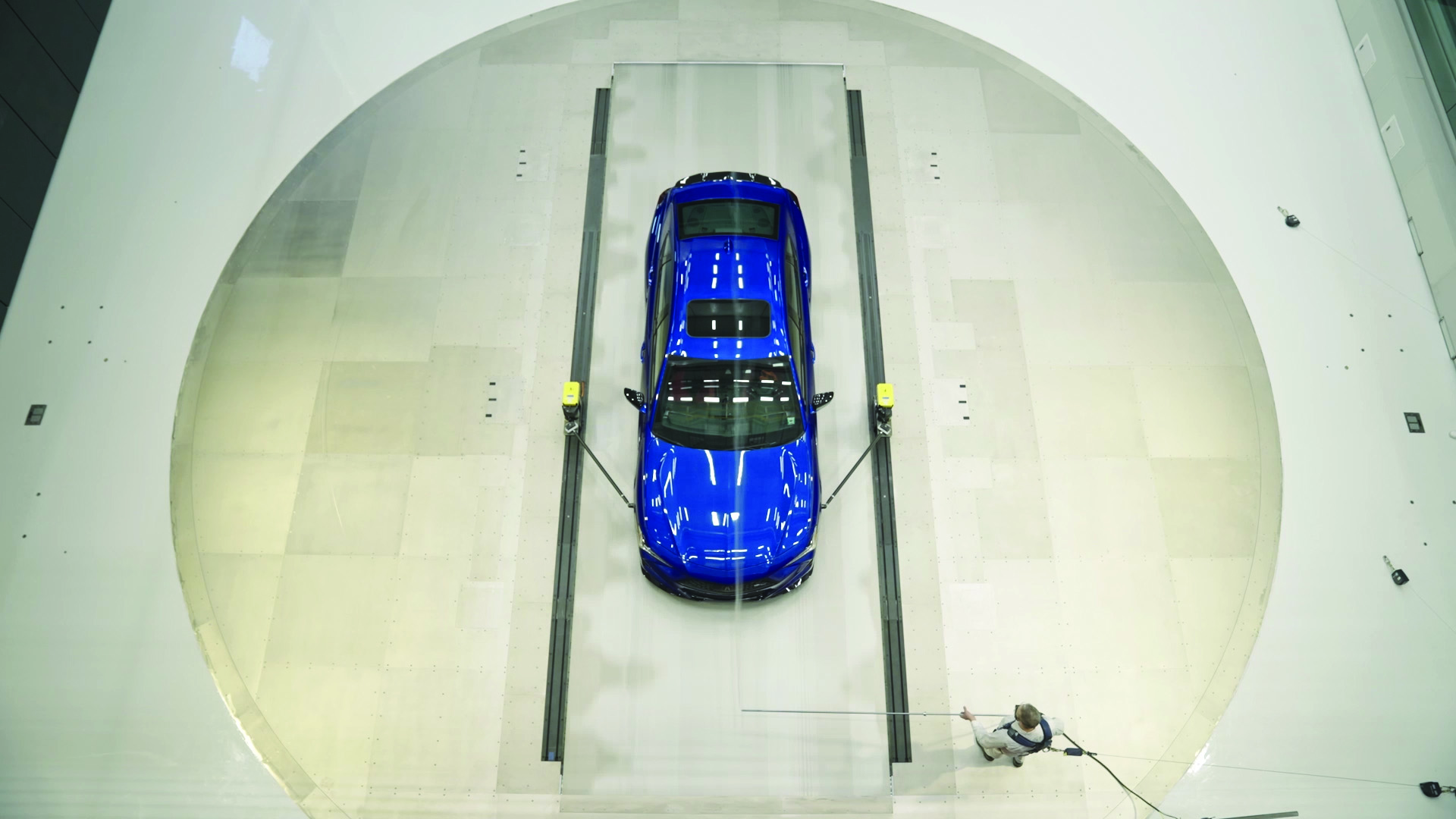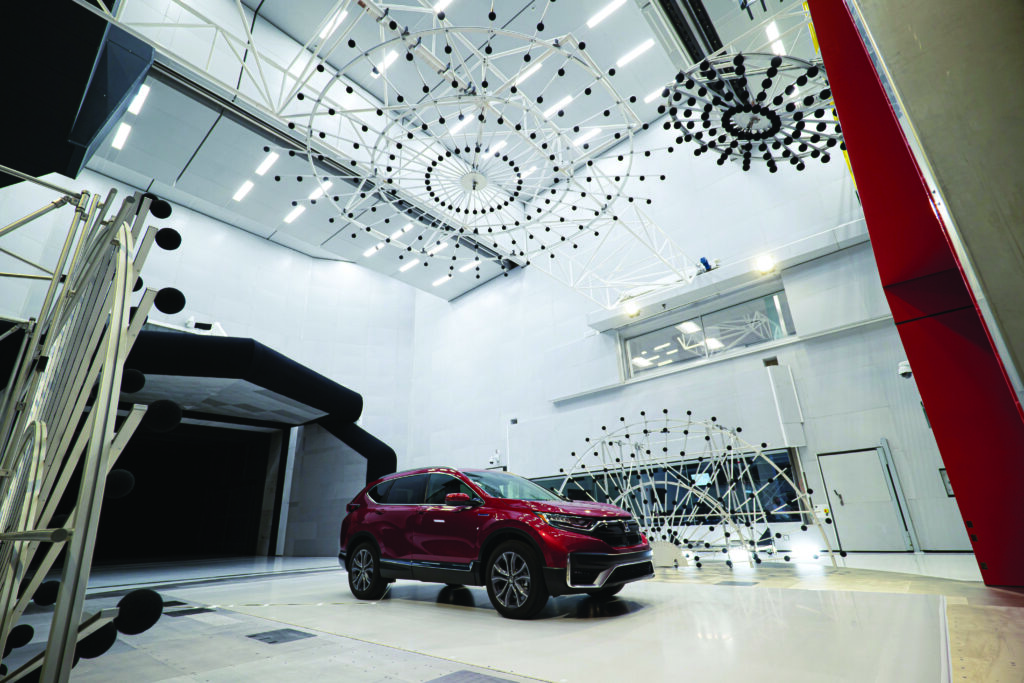Reports of the death of wind-tunnel testing are not just exaggerated, they’re wholly inaccurate. With a new generation of aero- and noise-sensitive BEVs on the horizon, Honda Americas is the latest OEM to renew its commitment to physical testing.
HALO (Honda Automotive Labs Ohio) is a brand-new, US$124m facility built at the Transportation Research Center (TRC) proving ground. Under construction since 2017, it became operational in early 2022 and is expected to take on full development loads this autumn. Note that HALO will ultimately amount to more than just the tunnel, as other, as-yet-undisclosed facilities come on stream.
Designing HALO
“When our initial discussions began in 2015, we were renting facilities around the world and using our three full-scale tunnels in Japan,” says HALO wind tunnel lead Mike Unger. “As our development load in Ohio increased, we started renting more, but the inefficiencies of shipping cars around the world, along with the wear and tear on our people – who were sometimes spending two weeks of every month away from home – became unsustainable.”
There’s already a 40%-scale tunnel just across the track at Honda’s Auto Development Center. “Even the scale tunnel can’t catch some of the extreme details that we’re after, especially the underbody-related parts,” continues Unger. “You need a full-scale car to zero in on that level of detail, to make sure you’re optimized in every way possible.”
Honda assembled an in-house team to define the most important performance specifications, to support current and future work in traditional aerodynamic activity and acoustic measurements. Unger expects HALO’s work to be split roughly 50/50 between the two disciplines.
“Having a full-scale wind tunnel to complement our scale wind tunnel is super critical as we move toward BEVs,” he explains. “Things will change somewhat in terms of both aerodynamics and wind noise. With regenerative braking, [unlike in an ICE-powered vehicle], mass is no longer the primary driver in the equation for range or fuel economy. The biggest factor is aerodynamics. And when the exhaust and the engine are gone, wind noise and road noise become much more apparent in the customer cabin. That’s
why this tunnel has the acoustic capability it does.”
Among HALO’s headline specifications are an ultra-quiet 8m fan that contributes to an acoustic environment rated at <57 dBA at 140km/h.
“We have a full acoustic array – left and right sides, top and front – so you can quickly measure and identify from where on the car the wind noise is coming,” says Unger. “That was chosen to improve our testing efficiency. Without that array, it would take three to four hours to do the basic measurements and identify where the noise sources are. With the array, it can be done in an hour.”
User friendly
In the pursuit of efficiency, the design team didn’t only consider high-tech features like the array, which is supplied by Siemens. They also drew on their experience of working in other tunnels to select the features they felt would work best for Honda, including when specifying the 12m-diameter, 180° turntable.
“Even simple things like loading and unloading a car were taken into account,” Unger continues. “We have two ways to get cars in and out of the tunnel. We can rotate the turntable to line up with the diagonal loading door and drive the car right onto the turntable. We rotate it into place and it’s good to go. When we leave, we can back it out and simultaneously bring another car in in parallel. If we’re staying in the same test mode, we can change the car in less than 30 minutes.
“Testing in a full-scale tunnel usually means long days, so we have a break room right next to the control room,” he adds. “We also have a patio so you can go outside and get some fresh air. You’re not stuck in a cave for 10-12 hours at a time. Since we lived it for so many years, we took into account the human factor when designing the tunnel.”
HALO is primarily a production car test facility, but the needs of Honda Performance Development’s (HPD) race teams were also considered. A maximum wind speed of 310km/h, a 3 x 5 x 15m test section and wide-belt moving ground plane all help to simulate race car speeds and characteristics. The latter is one of two switchable, 40-ton MTS moving ground plane modules. The second has a five-belt setup.
Once the main requirements were pinned down, Honda reached out to potential contractors. Jacobs was the successful bidder.
Location, location, location
The tunnel will support the two major manufacturing plants nearby with factory sampling and by verifying quality improvements for wind noise. Placing it within TRC’s existing boundary immediately affords an additional level of security, too.
Confidentiality will also be important to the tunnel’s future third-party users, for whom a dedicated team of contractors will operate the facility to provide separation from Honda (see Rent-a-HALO, above). Honda will run the tunnel for its own operations using a team of around 18 engineering and maintenance staff who will ensure things are running smoothly for internal projects before external clients come through the door.
“We have a consortium agreement with TRC,” says Unger of HALO’s future use by third parties. “We’d like HALO to be at the center of some aerodynamic research in North America. We’re hoping at the end of 2023 to have some of that consortium activity here on-site. That’ll be the first third-party customer use, after which we’ll start bringing in other customers as needed.”
Better together
Unger sees HALO ultimately developing into a center of excellence for aerodynamic and aeroacoustic development within Honda. He believes that the ability to mount a sensor to the traverse and place it anywhere in the test section will help to quickly answer engineers’ questions with high-quality data.
But more than that, “While it’s interesting to talk about the machine and its cool specs, the important thing to realize is prior to us having this tunnel, we had aerodynamic, aeroacoustic and racing engineers scattered all over the world doing testing. Now they’re all going to be in the same building, using the same piece of test equipment. They’ll share their individual experiences, techniques and measurement procedures. Through that collaboration, we’re going to come up with new ideas and develop brand-new procedures that are better than we’ve ever had before. That’s the real advantage of the tunnel. It’s going to be exciting.”

Rent-a-HALO
It’s unusual for an OEM wind tunnel to be available to third parties, but HALO has been designed from the outset with commercial users in mind. Badge-controlled zones maintain user confidentiality within four secure customer bays. As the commercial user moves its vehicle into the hallway and test section, those areas will be open only to that user group and its support staff.
“If a Honda competitor is in the building, third-party personnel will support the customer while they are at HALO,” clarifies Unger. “No Honda personnel would have access to their test or data.”
To prepare for tunnel testing, customers will have access to an alignment rack, tire mounting equipment and frontal-area measurement equipment. Other features available to third parties include tools, a surface plate, work benches, a kitchenette and a private office area and meeting room.
Each in its place
“Even when I started at Honda in 1992, there was talk that all wind tunnels would be obsolete in 10 years,” recalls Unger. “But here we are finalizing the new wind tunnel.” The former chief engineer for aerodynamics cites the need to use “the proper tool for the proper time and in the proper place” as the reason why CFD, scale tunnels and full-scale tunnels continue to co-exist in aerodynamic development.
“We have to use all the tools because we’re after every little detail of drag that we can eke out of the car,” he says. “There are some things you can do digitally that give you better insight into what’s going on, especially with visualization. But when you start talking about efficiency, let’s not kid ourselves: CFD is not cheap to run. Those licenses are not inexpensive. It takes an army of people to build a CFD model. It takes thousands of hours of CPU time to run the iterations. By the time you have a real car, it’s faster to test in a tunnel than it is to do CFD.”


